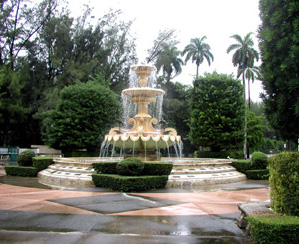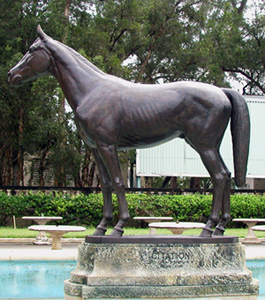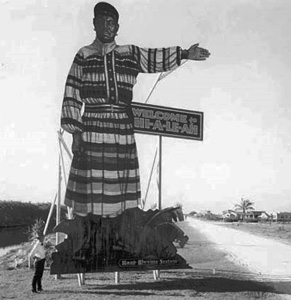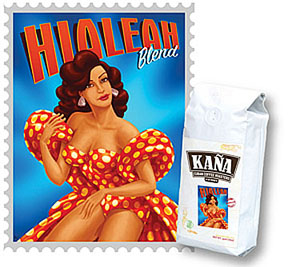1921 - sign depicting Seminole Jack Tigertail welcomes visitors to Hialeah (Courtesy Florida Archives/W. A. Fishbaugh)
In a small community to the north of Miami, aviation pioneer Glenn Curtiss and his partner James Bright built the racetrack to beat all racetracks: "Hialeah Park," a French château style palace surrounded by beautiful landscaped grounds with rows of stately Royal palm trees. A lake in the middle of the racetrack became famous for a huge flock of pink flamingoes the developers imported from Cuba.
The city surrounding this great horse track is Hialeah, a community that started as a small, sleepy town on the banks of the Miami canal, where barges transported sugar cane from fields near Lake Okeechobee in West Palm Beach to nearby sugar mills.

The park did not have much effect on the city of Hialeah: the hotels and planned communities that today would be a natural part of a major development were never built. The developers designed Hialeah Park not for the locals, but as a playground for the country club and beach crowd. In winter, the fancy hotels on Miami Beach shuttled glittering crowds of well-to-do guests to the park. Special trains brought day-tripping race goers down from Palm Beach.
It wasn't the racetrack, but the end of World War II that began a sea change for bucolic Hialeah. In the late 1940s and early 1950s, Hialeah experienced a housing boom when thousands of returning GIs settled in the city's tiny cinder block sub-divisions. With this steady supply of labor, hundreds of small factories and other enterprises sprung up to make Hialeah the industrial center of not just Miami, but all of south Florida.
Even in this period of growth, Hialeah had acres of open space and a small town feel. Horse ranches along the east side of the Palmetto rented horses by the hour. The McArthur Dairy milkman brought milk, cream and eggs and "tomato boys" went door to door selling freshly picked tomatoes. For years a tiny gas station on the corner of Palm and Okeechobee advertised, "Last chance for gas next 60 miles."
The 1960s brought the most drastic change and Hialeah was never the same. Cubans who had originally settled in the Little Havana neighborhood in Miami grew tired of the small apartments and bungalows and started to look for a place where they could buy a small home with a yard. Since thousands of Cubans worked in the city's shoe factories or clothing manufacturers, Hialeah, with low taxes and inexpensive housing, was a natural choice.


Historic Hialeah Park Racetrack before the remodeling. Statue of the famous racehorse "Citation."
Soon Hialeah became the most Cuban city in the United States, its streets lined with bodegas, fruterías, botánicas, farmacias, and clínicas. Hialeah became the capitol of "exile architecture," as the new arrivals painted the existing homes in warm colors of ochre, mango, and pink. Homeowners placed decorative wrought iron bars on the windows, erected shrines to their favorite saints, and installed a mandatory huge clay pot in the front yard. This pot, the tinajón, is always displayed resting on its side. Backyards filled with mango and papaya trees, while front yards remained treeless to accommodate the large paved driveways needed to park all the family's cars.
Hialeah is a busy town with a constant flow of traffic. Local shops are always full of activity and there is exuberance in the free-style form of capitalism practiced here. The city developed rapidly with planning that was at best haphazard and random, giving the city a free form, unplanned look that is comforting in its unpretentious appeal.
Hialeah is blue collar in every good sense of the term with hard-working people and strong family ties. It is a city where several generations typically live under one roof, frequently in "mother-in-law quarters" that residents attached to the original tract houses. Hialeah residents are passionate about their city and for many, it is as close as they will ever get to living again in Cuba. Residents pass summer evenings in friendly conversations with neighbors who gather on "el portal," the front porch, as they once did in Cuba.
The spirit of Hialeah in the "glory years" is captured by the Kaña Coffee company in the illustration for this dark espresso roast cafe Cubano.
Hialeah residents have a great sense of humor concerning the sometimes ram shackle reputation of their community. The unofficial motto of the city is "Hialeah: Lluvia, fango y factoría"—rain, mud, and factory. Most Hialeans would not have it any other way.
Tony Mendoza & Glenn Lindgren
ATMOSPHERE: Casual
PRICES: Many entrees priced less than $10.
- HOURS: 11:30 a.m. to 10:00 p.m. Tuesday through Sunday
CARDS: American Express, Diners Club, Discover, Mastercard, Visa
BAR: Beer and wine.
The Asturias Restaurant is a Hialeah mainstay that serves some great Cuban and Spanish dishes. Named for the province in Spain, Asturias has a strong Spanish influence. Asturias makes an excellent Fabada Asturiana, the signature dish of the province. The Fabada here is thick and flavorful, chock full of tender white beans and chunks of salty, smoky ham. Best of all – the maduros here are out of this world. We're not sure how they do it, but these are just about the best we've ever had. The edges are crispy, the natural sugars are fully caramelized, and the flesh is so sweet and so tender. You could eat these maduros over ice cream for a great dessert!
The pride of Hialeah: true Cuban soul food in a sparkling clean palace. A line forms on weekends here, but the tables turn over quickly and even a longer than normal delay is well worth it. A huge menu with some extraordinary dishes—bistec de hígado (liver steak) and frituras de seso (pork brains)—and plate busting portions. If you are not that adventurous, opt for the bistec Milanesa guajiro, (Milanese style steak) or Molina's excellent chicharrones de pollo (fried chicken chunks.) The black beans at Molina's are so rich and creamy you might skip the entrée and just order seconds.
The last race at Hialeah was in May 2001 and then the facility fell into disrepair. Ravaged by hurricane winds, the historic stables were razed in 2002. Local preservationists lobbied hard to keep the facility out of the hands of housing developers and in 2009, the track reopened with a short live racing season that runs in December, January, and February of each year.
Do not be confused by imitations. "Las Delicias" is one of the most popular restaurant names in Miami-Dade. If you have never experienced the delight of a basket of yuca frita and a dish of garlicky cilantro salsa, this is a good place to get started. The Hialeah crowd swears by the Cuban sandwiches and no one has ever gone wrong with the roast pork and a side of black beans and rice.
HOURS: Daily 11:00 a.m. to 10:00 p.m.
PRICES: Low to moderate
ATMOSPHERE: Casual
Chico's is where local politicos come to discuss the affairs of state over lunch. Open 24-7, the restaurant is a dependable destination for honest Cuban food at low prices. This kid-friendly spot serves a great breakfast and the palomilla steaks are fork tender. The restaurant has only closed twice in its history for hurricanes. Although they may board up the windows in a storm, the front door remains open.
HOURS: Daily, 24 hours
PRICES: Moderate
ATMOSPHERE: Casual
El Rinconcito De Santa Barbará
Puerto Rican favorites compete with Cuban mainstays. Island favorites like sorullos (stuffed corn fritters) and alcapurrias (fritters made with green plantain) for starters, then dig into the stomach stuffing mofongos, the Puerto Rican version of fufú that combines mashed plantains with flecks of pork and garlic. At El Rinconcito, you can have your mofongo with pork, chicken, fish, shrimp, and even lobster!
HOURS: Open Sunday through Thursday, 8:00 a.m. to 10:00 p.m. | Friday and Saturday 8:00 a.m. to 11:00 p.m.
PRICES: Moderate
ATMOSPHERE: Casual
HOURS: Daily 11:00 a.m. to 11:30 p.m.
PRICES: Moderate
ATMOSPHERE: Business casual
Molina's Ranch Restaurant
Hialeah Park Racetrack
2200 East 4th Avenue
Hialeah, FL 33056
305-885-8000
Asturias
3930 East 4th Avenue
Hialeah, FL 33013
305-822-4581
Las Delicias Restaurant
4660 West 4th Avenue
Hialeah, FL 33014
305-364-9070
Chico's
4070 W 12th Avenue
Hialeah, FL 33014
305-556-8907
El Rinconcito De Santa Barbará
2050 West 56th Street
Hialeah, FL 33014
305-819-5590
- Molina's Ranch Restaurant
- 4100 East 8th Avenue
- Hialeah, FL 33013
- 305-687-0008









